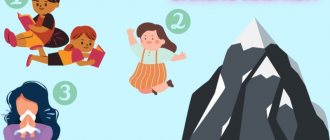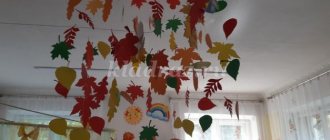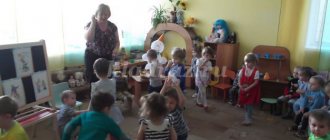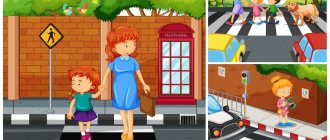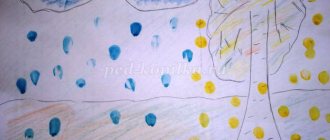MAGAZINE Preschooler.RF
Summary of a lesson on developing a healthy lifestyle in the first junior group “The bears came to visit us”Municipal autonomous preschool educational institution combined type kindergarten "Fairy Tale" Ak-Dovurak, Republic of Tyva
Educational areas: physical education, communication, cognition.
Goals:
- develop children’s physical activity, create a desire to engage in physical education; introduce children to objects in their immediate environment: a bear toy; learn to describe a toy (name parts, size, characteristics), compare large and small toys;
- cultivate a love for animals.
Equipment: two teddy bears of different sizes, a handkerchief, pine cones, a basket, a tape recorder, health tracks.
Progress of the lesson.
1. Organizational moment.
-Guys, stand in a circle. Today some guests came to visit us for class. Let's say hello.
Now, children, let's play the game "Carousel"
Barely, barely, barely, barely, The carousels began to spin, And then around, around, Everyone ran, ran, ran!
(run in a circle 2-3 times)
Now we stop and rest (exercise - inhale, exhale).
-Well done kids, we had a great ride.
-Children, look here, do you see the path?
(Points to the massage paths.)
- We'll follow it.
Children walk one after another along the massage paths.
2. Main part. Looking at a toy.
- Guys, another guest came to our lesson. He hid under a handkerchief. First, children, guess the riddle about him.
The owner of the forest wakes up in the spring. And in winter, under the blizzard howl, he sleeps in a snowy hut.
(bear)
-Learned! Who came to visit us? Well done!
-Children, come closer to the bear, stroke its fluffy fur, touch its ears, look at its eyes, nose, soft paws, and tummy. (children look at the bear and touch it)
-What bear? (the teacher encourages the children to speak with her).
-Is our bear fluffy?
-His ears are small and soft?
-His paws are soft?
-Is your tummy soft?
-Is the tail soft and small?
-Are your eyes round, like buttons?
-Now name the parts of the toy? (head, belly, paws, back, tail, nose).
3. Physical education minute
The clumsy bear is walking through the forest, collecting cones, singing a song, suddenly a cone fell, right on the bear’s forehead. The bear got angry and stamped his foot
4. Comparison of bears of different sizes.
- Guys, the bear wants to tell me something. (listens to the bear)
-Mishka said that he came alone, but with a friend. His friend is also hiding. Let's see who he is. (takes out a toy bear from under a small scarf).
-Who is this, guys? (Bear.)
Next, pointing first to the small bear, then to the big one, he asks a question;:
-Is this bear the same?
-This bear is big, and this one is small. The big bear has big ears, the little bear has small ears...
5. Game “Collect cones”
-Children and bears love to play with pine cones. Let's collect cones for the bears in a basket. (Before class, the teacher had already scattered the pine cones on the carpet.)
Children collect cones in a basket while listening to music. When the children have already collected, the teacher brings a box with a bow and says:
-Well done, children, the bear is very glad that you collected pine cones for them and gives you gifts in gratitude. (The teacher takes candy from the box and distributes it to the children.)
-Now it's time to say goodbye to the bears. Let's say to the bears: "Goodbye!"
6. Reflection.
-Who did we play with in class?
(before goodbye, the teacher suggests playing with the bears some more: cooking them porridge, putting on aprons, feeding them porridge from a spoon.)
Methodological literature used:
- Complex classes according to the program “From birth to school” edited by N.E. Veraksy, T.S. Komarova, M.A. Vasilyeva. Publishing house "Teacher" - 2013
- Physical education classes in kindergarten. E.F. Zhelobkovich. Second junior group. -M.: Publishing house “Scriptorium 2003” , 2009.
| Next > |
Lesson summary on healthy lifestyle in the first junior group
Healthy lifestyle in the 1st junior group “Journey to the Magic Garden”
Author: Solunina N.V. Goal: to consolidate children’s understanding of the health benefits of vegetables and fruits. Objectives: To give an idea of health care, of caring for your body, of what is healthy (vitamins), to learn to recognize and name vegetables and fruits: cabbage, carrots, onions, apples, pears. Fix the quantitative ratio - a lot. Practice distinguishing the primary colors of the spectrum. Develop empathy for the character. Materials for the lesson: Toy doll, dummies of vegetables and fruits, flannelgraph with a miracle tree.
Progress of the lesson
Children sit in a semicircle. There is a knock on the door. Educator: - Guys, do you hear? Someone came to us. Let's get a look? The teacher opens the door and brings in the doll.
Educator: - Guys, who is this? That's right, a doll, her name is Katya. Let's say hello to her! Educator: (addresses the doll) - Do you want to play with us? Katya: - No, guys, I don’t want to. Educator: - Let us treat you to something, you came to visit the children, and they are always happy to have guests! Katya: - I don’t want anything... Educator: - What happened to you, you’re so sad, you don’t want anything. Guys, what happened to our doll? Let's listen to what she tells us? Katya tells the teacher that her throat hurts. Educator: -Katya, why does your throat hurt? Katya: - Yesterday I ate ice cream on the street... Teacher: - Well, when it’s cold outside, you can’t eat ice cream, you have to take care of the neck! The teacher asks the children to show where their neck is and to stroke it.
Katya ate the ice cream, so her throat hurt.
We told our doll that eating ice cream on the street is dangerous. The doll says that she will no longer eat ice cream on the street, she will take care of the neck. Educator: Guys, let's give Katya a scarf to warm her neck. The teacher and the children tie a scarf to the doll. Educator: Children, so that the doll gets better faster, we will treat it with vitamins. The game “Let's treat the doll with vitamins” is played . Children insert colored circles into slots in the corresponding colored box.
There are different vitamins: yellow and red. We will insert it into the slots and treat our doll. Educator: - Guys, do you know that vitamins are found in vegetables and fruits? You should definitely eat healthy vegetables and fruits! The game “Wonderful Bag” is played (with dummies of vegetables and fruits)
.
It’s interesting to see what lies in the wonderful bag.
Vegetables and fruits are healthy foods! Educator: Katya, do you know where apples and pears grow? Katya: No, I don’t know. Maybe the guys can give me some advice? (children's answers). Educator: Guys, let's show Katya our magical orchard. The simulation game “Getting dressed for a walk” is played .
We came to the magical garden. The tree of miracles was found. We will collect pears and apples on it in a basket. Children with a teacher and a doll approach a tree on which apples and pears “grow”. The teacher draws attention to the fact that there are a lot of fruits on the tree. Offers to harvest. Each child “plucks” the fruit that the teacher names. The children put the collected apples and pears in a basket and give them to the doll Katya.
Katya: Guys, I really liked your magical forest, can I walk here a little more? Educator: And you and I, children, it’s time to go to kindergarten. Let's say goodbye to Katya, tell her goodbye.
We recommend watching:
Scenario of spring entertainment for children of the junior group Notes of the lesson “Butterflies” in the junior group Notes of the lesson on healthy lifestyle in kindergarten in the 1st junior group Notes of the lesson on healthy lifestyle in the 1st junior group. Vitamins
Similar articles:
Lesson summary for an early age group. Vegetables: turnips and carrots
Lesson summary for an early age group. Vegetables: beets and potatoes
Lesson summary for an early age group. Fruits: lemon and orange
Lesson summary for an early age group. Cat with kittens
Summary of a lesson in an early age group on a winter theme. Hare and fox
Educational objectives:Give an idea of health care, caring for your body, and what is healthy (vitamins).
Educational tasks:
Develop the ability to listen to the teacher, teach to treat animals with care, cultivate love for them, empathy.
Material for the lesson:
Toy (puppy), plasticine, modeling boards, pictures of vegetables.
Previous work:
Familiarization with vegetables, learning to recognize in object pictures.
Methods and techniques:
1. Surprise moment
2. Reading a poem
3. Incentives
Progress of the lesson
Children sit in a semicircle.
Someone knocks on the door, the teacher attracts the children's attention.
- Guys, do you hear? Someone came to visit us. Let's get a look?
The teacher opens the door and the puppy comes in.
- Guys, who is this? That's right, a puppy (small dog). Let's say hello to him.
The puppy greets the children with a sad voice.
- Do you want to play with us?
- No .
- Let us treat you to something, you came to visit the guys, and they are always happy to have guests!
- No.
“What happened to you, you’re so sad, you don’t want anything.” Guys, do you know what happened to the puppy? Let's listen to what he tells us?
The puppy tells the teacher, and then, in turn, the children, stroking the puppy:
- Poor little puppy, he got sick, fell ill,
Even his throat hurts, he is now sitting idle.
His tummy hurts, his back hurts, he needs medicine,
Or better yet – VITAMIN!!
The teacher asks the puppy why his throat hurts, the puppy explains that he was barking loudly on the street. The teacher tells the puppy that when it’s cold outside you can’t bark loudly, you need to take care of your throat. The teacher asks the children to show where their neck is and to stroke it. He says that his little children know how to behave on the street and how to breathe through their noses.
- Let’s now turn into little hedgehogs and breathe in and out through our noses.
Children perform the exercise 2-3 times.
The puppy replies that he understood everything, thanks the guys, and that he will no longer bark loudly on the street, he will take care of his neck.
- Guys, I know how else you can preserve your health. You should definitely eat healthy vegetables. (the teacher shows pictures with carrots and cabbage, asks the children what they are) . There are many useful vitamins there (shows a picture of how vitamins are distributed to children).
The puppy says that he doesn't like carrots or cabbage. The teacher consoles him and says that there are special vitamins in a jar. The puppy says he didn't see them. The teacher asks the children for help to see if they want to make vitamins for the puppy that are good for health and put them in a jar. The children agree.
“But first we’ll play a little, stretch our fingers.”
Our red flowers are opening their petals (children open their fingers)
The breeze breathes slightly, the petals sway. (shaking hands)
Our red flowers cover their petals (fingers closed)
They shake their heads and quietly fall asleep. (shaking hands)
Children make “vitamins”
Children sit at tables and “put” vitamins into a jar, then show them to the puppy; The teacher reminds the children that vitamins are good for health. The puppy says “thank you” to all the children.
Children are encouraged to play with the puppy some more.
Junior group. Early childhood, nursery. Children 1-4 years old
Summary of a lesson on the use of health-saving technologies with children 3–4 years old If there is health, a person is happy , lives peacefully, works, studies, goes to kindergarten. Without health you cannot live , you cannot love, you cannot be beautiful, charming. The first steps to health , the desire for a healthy lifestyle , to self-knowledge, the formation of a culture of health .
Abstract of the educational standard for a healthy lifestyle “I want to be healthy” (junior group) Abstract of the educational standard for a healthy lifestyle : “
I want to be healthy ” (junior group)
Goal: to develop in children the foundations
a healthy lifestyle , the need to maintain their health . Objectives: to form in children primary knowledge about a healthy lifestyle ; evoke a desire to take care of your health ;.
